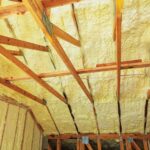Preparing your home for a storm is crucial, especially when it comes to managing roof drainage. Properly maintaining and preparing your roof’s drainage system can prevent significant damage from heavy rains and storms. In this guide, we will provide essential roof drainage tips for storm preparation to help you protect your home and ensure that your roof drainage system is in optimal condition.

Understanding the Importance of Roof Drainage
Before diving into the tips, it’s important to understand why roof drainage is vital. A well-functioning drainage system helps in directing water away from your home’s roof, preventing leaks, water damage, and even structural issues. By ensuring effective roof drainage, you can safeguard your home against the damaging effects of storms.
Potential Risks of Poor Roof Drainage
Poor roof drainage can lead to various problems, including water pooling, roof leaks, and damage to the structural integrity of your home. Water accumulation can also lead to mold growth, which poses health risks to the inhabitants. Therefore, proper roof drainage is essential for maintaining the safety and longevity of your home.
Inspecting Your Roof Drainage System
Regular inspection of your roof drainage system is a crucial step in storm preparation. By identifying and addressing potential issues early on, you can avoid costly repairs and ensure that your system functions efficiently during a storm.
Visual Inspection
Start with a visual inspection of your roof. Look for signs of damage, such as cracks, loose shingles, or clogged gutters. Pay attention to areas where water tends to pool or where debris accumulates.
Check Downspouts and Gutters
Ensure that your gutters and downspouts are clear of debris. Clogged gutters can lead to water overflow, which can damage your roof and home’s exterior. Regular cleaning is essential to maintain proper drainage.
Maintaining Your Roof Drainage System
Proper maintenance is key to ensuring the effectiveness of your roof drainage system. Here are some maintenance tips to keep your system in top condition:
Regular Cleaning
Clean your gutters and downspouts regularly to prevent blockages. Use a garden hose to flush out any debris and ensure that water flows freely through the system.
Trim Overhanging Branches
Trim any tree branches that hang over your roof. Falling leaves and branches can clog your drainage system, leading to water buildup and damage.
Inspect for Damage
Regularly inspect your roof for signs of damage, such as cracked or missing shingles, damaged flashing, and loose gutters. Addressing these issues promptly can prevent further damage during a storm.
Enhancing Roof Drainage for Storms
In addition to regular maintenance, there are steps you can take to enhance your roof drainage system for better storm preparation:
Install Gutter Guards
Consider installing gutter guards to prevent debris from entering your gutters. Gutter guards can reduce the frequency of cleaning and help maintain optimal water flow.
Ensure Proper Slope
Ensure that your gutters and downspouts are properly sloped to facilitate water flow. An improper slope can lead to water stagnation and overflow.
Add Additional Downspouts
If your roof experiences heavy rainfall, consider adding additional downspouts to improve water drainage. This can help prevent water pooling and reduce the risk of damage.
Preparing for a Storm
Before a storm hits, take the following steps to prepare your roof and drainage system:
Secure Loose Items
Secure any loose items on your roof, such as antennas or satellite dishes, to prevent them from being dislodged during high winds.
Check for Leaks
Inspect your roof for any signs of leaks and address them promptly. Leaks can worsen during a storm, leading to extensive damage.
Review Insurance Coverage
Review your homeowner’s insurance policy to ensure that you have adequate coverage for storm-related damage. This can provide peace of mind and financial protection.
After the Storm
After a storm, it’s important to assess any damage and take steps to repair and maintain your roof drainage system:
Inspect for Damage
Inspect your roof for damage caused by the storm. Look for missing shingles, damaged gutters, and any other signs of wear and tear.
Conduct Repairs
Conduct necessary repairs promptly to prevent further damage. This may include replacing missing shingles, resealing flashing, or repairing damaged gutters.
Prevent Future Damage
Take steps to prevent future damage by reinforcing your roof and drainage system. This may include upgrading materials or implementing additional drainage solutions.
Conclusion
Proper roof drainage is essential for protecting your home from the damaging effects of storms. By following these roof drainage tips for storm preparation, you can ensure that your home is ready to withstand heavy rains and high winds. Regular maintenance, inspection, and enhancement of your roof drainage system can prevent costly repairs and extend the life of your home.

FAQs
How often should I clean my gutters?
It’s recommended to clean your gutters at least twice a year, ideally in the spring and fall. However, if you have overhanging trees, more frequent cleaning may be necessary.
What should I do if my gutters are overflowing during a storm?
If your gutters are overflowing, it’s likely due to a blockage. Check for debris and clear it as soon as possible to restore proper drainage.
Can I install gutter guards myself?
Yes, gutter guards can be installed as a DIY project. However, if you’re not comfortable with heights or unsure about the installation process, it’s best to hire a professional.
For more information on ensuring proper roof water runoff, visit this link. To learn about best roof drainage solutions for DIY projects, check out this resource. Additionally, for tips on sealing roof drainage systems, explore this article.
For more professional insights, you can also read about roof drainage systems.
This article contains affiliate links. We may earn a commission at no extra cost to you.







